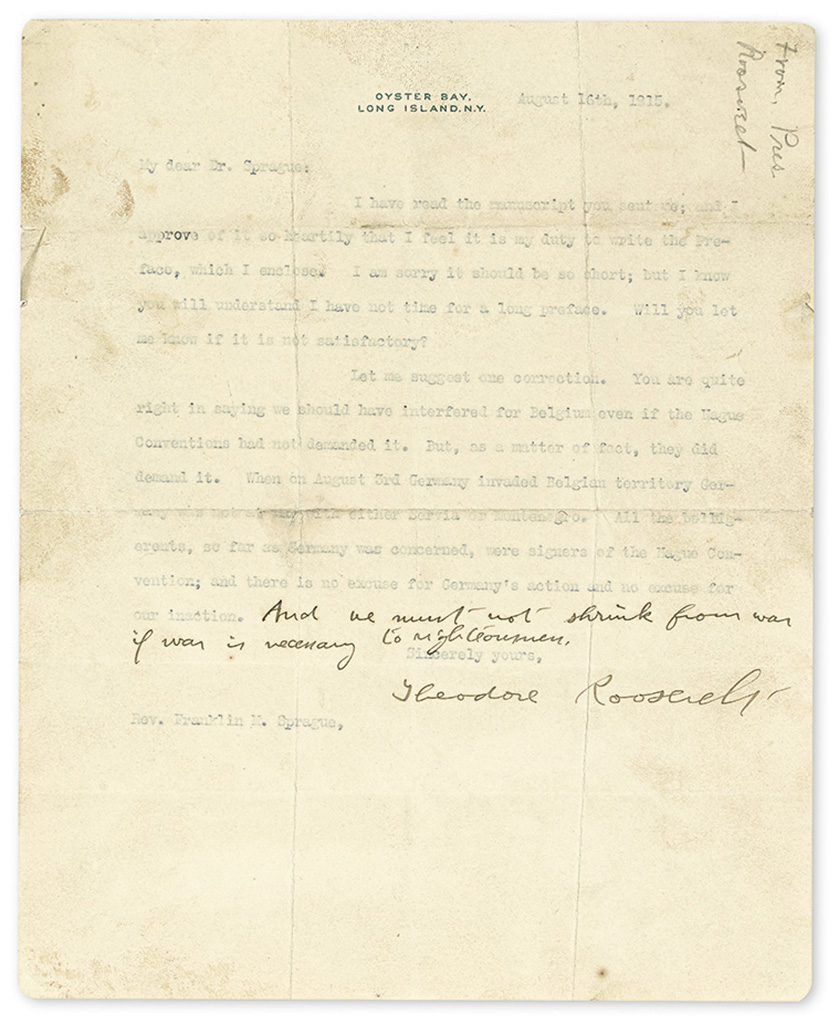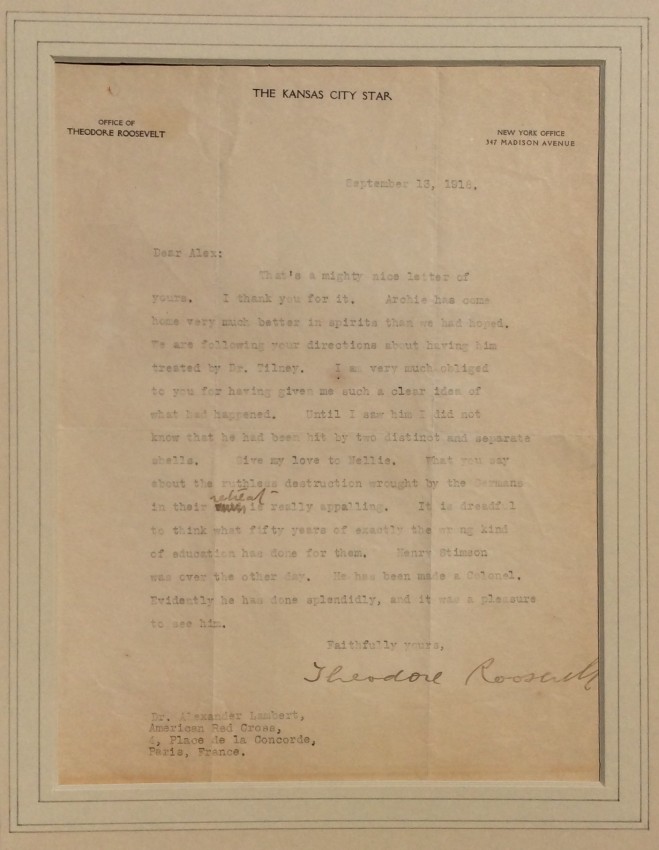ROOSEVELT, Theodore. Typed manuscript, two pages from the campaign speech Roosevelt carried in his pocket in Milwaukee on 14 October 1912, when he was shot by a would-be-assassin, the bullet passing through the folded pages. 2 pages, 4to, originally folded once horizontally. The sheets displaying an irregular bullet hole at top and in lower portion of the sheet . With : Original legal-size envelope, imprint of the Progressive National Committee, Chicago, Ill., bearing a penciled note: "Portion of speech in Roosevelt's pocket when shot." "IT TAKES MORE THAN THAT TO KILL A BULL MOOSE!": PAGES FROM THE SPEECH THAT FOILED ROOSEVELT'S 1912 ASSASSINATION A remarkable and sobering relic of the attempted assassination of Roosevelt, who had become President after the shooting of William McKinley 11 years earlier. Roosevelt, the Progressive Party candidate for President, had arrived in Milwaukee late in the day on a critical final campaign swing through key states. In Milwaukee he attended a private dinner at a local hotel. Then, preparing to step into a car, Roosevelt stood up and waved to the crowd that had gathered at the entrance. The gunman, a deranged bartender named John Schrank, raised a 38-caliber revolver and fired at Roosevelt at close range. (Schrank was later quoted as vowing that "any man looking for a third term [as President] ought to be shot.") Fortunately for the Progressive Party candidate, the bullet penetrated the folded speech carried in Roosevelt's inside vest pocket and a metal spectacle case, significantly slowing the missile and deflecting it so that it inflicted a non-fatal chest wound, fracturing one rib. Roosevelt made light of the wound, and proceeded to the auditorium. "You see," he cried, holding up the manuscript so that the audience could see the bullet hole through the sheets of paper, "It takes more than that to kill a Bull Moose." After speaking for an hour to the huge crowd, with the bullet still in his body, Roosevelt collapsed, weakened by the loss of blood, and was rushed to a hospital for medical treatment. He was hospitalized in Chicago for 8 days, and was only discharged on October 23, 1912 -- a few days before the election. The bullet had effectively stopped Roosevelt's campaign. "The assassin's bullet played an unique role in the Presidential career of Theodore Roosevelt. He became president when McKinley was shot... and his efforts to regain the presidency from Taft in the campaign of 1912 ended for all practical purposes in Milwaukee with his own attempted assassination" (W. J. Foley, "A bullet and a Bull Moose," in JAMA, 1969, 209:2035-2038). This portion of Roosevelt's speech is quite an interesting one, complete in itself, containing a lengthy quotation from competing candidate Robert La Folette of Wisconsin, exuberantly praising Roosevelt's accomplishments while President: "These are the views that Senator La Follette held of my Administration, and they must control as against anything that is now said of that administration...." Roosevelt had pledged in 1904 not to seek another term as President. But in 1912, disturbed by what he saw as conservative tendencies of his successor, William H. Taft, Roosevelt proclaimed his candidacy under the Progressive, or Bull Moose ticket. In spite of an energetic campaign, his candidacy fatally divided the Republican Party, ensuring the victory of Democrat Wilson. VERY RARE: No other fragment of the speech that helped to save Roosevelt from assassination is listed in ABPC since at least 1975. Provenance : Probably given by Roosevelt to a friend or supporter, during his hospitalization in Chicago, 15-23 October, 1912.
ROOSEVELT, Theodore. Typed manuscript, two pages from the campaign speech Roosevelt carried in his pocket in Milwaukee on 14 October 1912, when he was shot by a would-be-assassin, the bullet passing through the folded pages. 2 pages, 4to, originally folded once horizontally. The sheets displaying an irregular bullet hole at top and in lower portion of the sheet . With : Original legal-size envelope, imprint of the Progressive National Committee, Chicago, Ill., bearing a penciled note: "Portion of speech in Roosevelt's pocket when shot." "IT TAKES MORE THAN THAT TO KILL A BULL MOOSE!": PAGES FROM THE SPEECH THAT FOILED ROOSEVELT'S 1912 ASSASSINATION A remarkable and sobering relic of the attempted assassination of Roosevelt, who had become President after the shooting of William McKinley 11 years earlier. Roosevelt, the Progressive Party candidate for President, had arrived in Milwaukee late in the day on a critical final campaign swing through key states. In Milwaukee he attended a private dinner at a local hotel. Then, preparing to step into a car, Roosevelt stood up and waved to the crowd that had gathered at the entrance. The gunman, a deranged bartender named John Schrank, raised a 38-caliber revolver and fired at Roosevelt at close range. (Schrank was later quoted as vowing that "any man looking for a third term [as President] ought to be shot.") Fortunately for the Progressive Party candidate, the bullet penetrated the folded speech carried in Roosevelt's inside vest pocket and a metal spectacle case, significantly slowing the missile and deflecting it so that it inflicted a non-fatal chest wound, fracturing one rib. Roosevelt made light of the wound, and proceeded to the auditorium. "You see," he cried, holding up the manuscript so that the audience could see the bullet hole through the sheets of paper, "It takes more than that to kill a Bull Moose." After speaking for an hour to the huge crowd, with the bullet still in his body, Roosevelt collapsed, weakened by the loss of blood, and was rushed to a hospital for medical treatment. He was hospitalized in Chicago for 8 days, and was only discharged on October 23, 1912 -- a few days before the election. The bullet had effectively stopped Roosevelt's campaign. "The assassin's bullet played an unique role in the Presidential career of Theodore Roosevelt. He became president when McKinley was shot... and his efforts to regain the presidency from Taft in the campaign of 1912 ended for all practical purposes in Milwaukee with his own attempted assassination" (W. J. Foley, "A bullet and a Bull Moose," in JAMA, 1969, 209:2035-2038). This portion of Roosevelt's speech is quite an interesting one, complete in itself, containing a lengthy quotation from competing candidate Robert La Folette of Wisconsin, exuberantly praising Roosevelt's accomplishments while President: "These are the views that Senator La Follette held of my Administration, and they must control as against anything that is now said of that administration...." Roosevelt had pledged in 1904 not to seek another term as President. But in 1912, disturbed by what he saw as conservative tendencies of his successor, William H. Taft, Roosevelt proclaimed his candidacy under the Progressive, or Bull Moose ticket. In spite of an energetic campaign, his candidacy fatally divided the Republican Party, ensuring the victory of Democrat Wilson. VERY RARE: No other fragment of the speech that helped to save Roosevelt from assassination is listed in ABPC since at least 1975. Provenance : Probably given by Roosevelt to a friend or supporter, during his hospitalization in Chicago, 15-23 October, 1912.















Try LotSearch and its premium features for 7 days - without any costs!
Be notified automatically about new items in upcoming auctions.
Create an alert